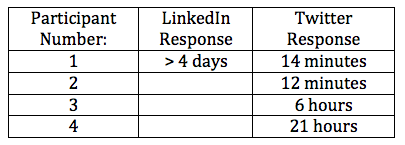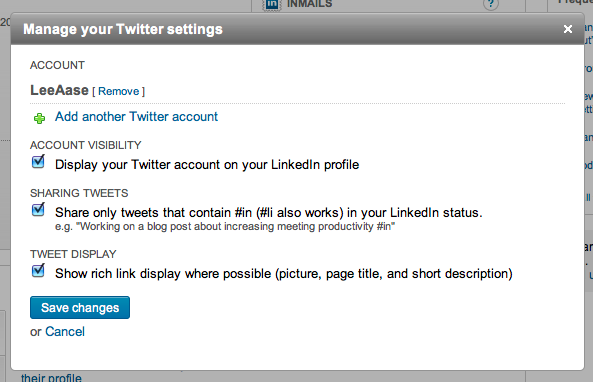In the last week, I’ve needed to get in touch with a few people via email about a social media project. For a few of them, I was missing email addresses so needed to contact the participants first by some other means to ask them to send their email addresses.
For Contact #1, I knew we were connected on LinkedIn, so I decided to send him a message through that service on Friday, Dec. 30.
For the next three, I checked first to see whether they were following me on Twitter, and sent them direct tweets instead.
Finally, yesterday, after having not heard from #1, I sent a direct tweet.
Here is the table of my results:
I realize this isn’t a large enough sample to be statistically meaningful. I also realize that my LinkedIn message was sent on a Friday before a holiday weekend, so it probably wasn’t the fairest test. But I wasn’t exactly fair to Twitter, either. For participants 2-4, I sent the tweets in the mid-to-late evening, possibly after some had gone to bed (they were all an hour ahead of me in the Eastern time zone). Number 3 responded at 4 a.m. I sent a follow-up to Number 4 the next afternoon, and this time the response was less than 2 hours.
Still, these results do fit with what I perceive as my experience in the relative responsiveness of Twitter vs. LinkedIn.
I think it relates to the way most people interact with the platforms. I don’t have statistics to support this (if you have some, please put them in the comments), but it seems people tend to use LinkedIn through its Web site. When you send someone a message in LinkedIn, therefore, people see it when they visit the site, or possibly through an email notification.
On Twitter, people can get notifications of new messages in those ways, but also tend to use smart phone clients or get text message alerts. This makes it much more likely they will get the notice quickly, wherever they are.
I’m not hacking on LinkedIn; it obviously has capabilities Twitter doesn’t, and you need to use different tools depending on what you want to accomplish. For soliciting and organizing professional recommendations, for instance, LinkedIn is clearly superior.
I have the LinkedIn iPhone app (although I haven’t used it much) and it probably offers push notifications as the Twitter app does (again, I welcome confirmation in the comments). My point isn’t that people couldn’t respond as quickly on LinkedIn as they do on Twitter, it’s just that in my experience they don’t.
How about you?
When you need to reach someone quickly, and if you don’t have the old-school contact information such as email or cell phone (and yes, having grown up with a single land line and snail mail, I realize the irony of calling email and cell phone “old school”), what do you find is the best social platform to use?

